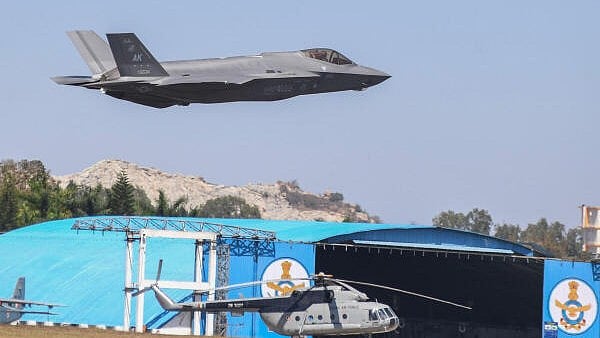
F35 Aerial display at Aero India 2025 by Ministry of Defence and Department of Defence Productions at Yelahanka Air Force Station Bengaluru on Wednesday 12th February 2025.
Credit: DH Photo/ S K Dinesh
The multi-billion-dollar question being debated, in the wake of United States President Donald Trump’s offer to sell to India the most advanced stealth fighter jet in the world, is: will the US F35 Lightning soon sport Indian Air Force (IAF) roundels?
Trump announced Washington’s willingness to negotiate a deal on the F35 with India in a joint statement on February 13 after meeting Prime Minister Narendra Modi at the White House. The F35 has been given only to some key US allies including the United Kingdom, Australia, Israel, Japan, South Korea, Italy, Norway, the Netherlands, and Belgium.
The IAF would be keen to evaluate Trump’s F35 proposal for several reasons. The IAF is desperately looking for solutions to arrest the depleting squadron levels in its fighter fleet which is operating with 31 squadrons against a sanctioned strength of 42. India’s Multirole Fighter Aircraft (MRFA) programme, which seeks to address this by adding 114 fighter aircraft from foreign vendors, has been delayed by more than seven years, and requests for proposals have not even been sent out. The MRFA, alongside the newly inducted Rafales and the Light Combat Aircraft Mk 2s (when they become operational) are supposed to hold the fort till the indigenously developed fifth-generation fighter, the Advanced Medium Combat Aircraft (AMCA) takes to the skies more than a decade away.
It is imperative for the IAF to acquire fifth-generation fighters with stealth features sooner rather than later to counter the ballooning numbers of fifth-generation J20s fielded by China. The Pakistan Air Force too is increasing its fighter squadron strength with an indeterminate number of J35 stealth jets ‘gifted’ by China. Even the induction of the full complement of MRFA, when that happens, will not give the IAF any advantage over the advanced fighters of China and Pakistan. So, it is a no-brainer for the IAF to buy a fifth-generation jet off the shelf now.
The F35 was never officially offered to India before, albeit it was showcased at the Yelahanka Air Force station in Bengaluru during the Aero India 2023 — its first-ever appearance in the country — and again at this year’s edition of the air show. The US seemed more interested in hard selling its F21 (an advanced variant of the vaunted F16 Fighting Falcon) to New Delhi. The F21’s manufacturer, Lockheed Martin, says the F21 has been specially modified for Indian conditions, with ‘some’ stealth capabilities and “30 per cent lower life cycle costs” compared to other twin-engine fighters in its class.
Lockheed Martin even announced a partnership with Tata Advanced Systems to assemble the F21 in the subcontinent if New Delhi plumped for the jet. Against this backdrop, it should not be surprising if Washington’s F35 offer turns out to be conditional on India buying the F21 first. Under Trump, US foreign policy decisions will be more transactional than ever before, and it is unlikely that Washington would sell the F35 unconditionally to India.
The F35 is built to counter Russian air defence systems (ADS) and the Americans would be taking a big risk in selling it to a country like India that uses the Russian S400 ADS. The last thing the Pentagon would want would be for the F35’s zealously guarded stealth technology falling into Russian hands. Similar fears of China getting hold of the technology had prompted Washington to refuse even Taipei’s request for the aircraft, despite a robust US-Taiwan security partnership.
From all accounts, assuming an agreement on the F35 fructifies, the IAF is likely to opt for a couple of F35 squadrons in anticipation of the AMCA’s arrival post-2035. However, this may not be a realistic scenario as the IAF would be forced to overlook the F35’s nearly $100 million price tag, its expensive maintenance, and the as-yet-unclear strings attached to the contract.
The Pentagon is accustomed to monitoring and modifying end-user agreements in the sale of advanced military technologies — often with unacceptably stringent strictures — and the F35 is no exception. This includes access denial in many key domains ranging from weaponry and avionics to communication systems. Therefore, considering that even close US allies are forced to go back to the US for any modification of their F35s, the IAF should be prepared to live with a trade-off that includes not being able to customise any feature on the aircraft.
It will not be easy either for the IAF to deal with the difficult logistics involved in inducting the F35. For instance, being the lone fifth-generation aircraft in the air arm, the F35’s disparate combat networking could complicate the task of achieving interoperability with other fighters. This is especially daunting given India’s focus on force modernisation by acquiring indigenous platforms under atmanirbharta (self-reliance). The Air Force should consider all these challenges before choosing the best option to future-proof its fighter arm.
(Prakash Chandra is former editor of the Indian Defence Review. He writes on aerospace and strategic affairs.)
Disclaimer: The views expressed above are the author's own. They do not necessarily reflect the views of DH.